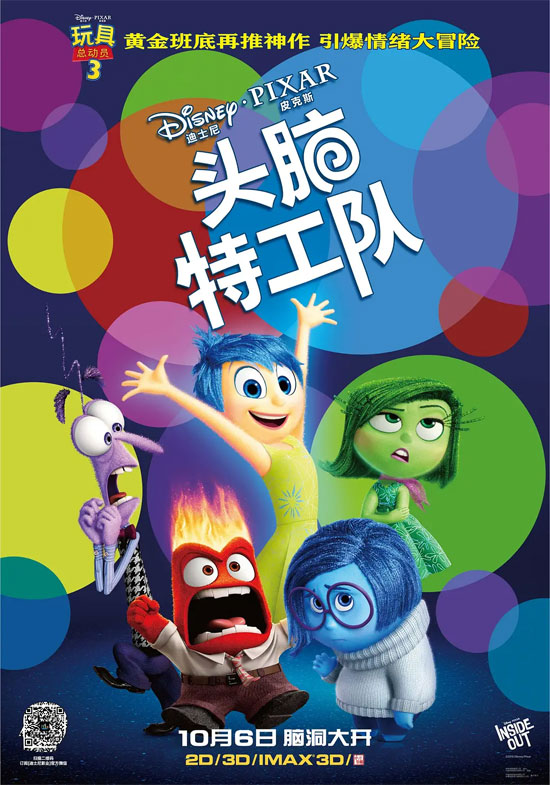Film Name: 头脑特工队 / Inside Out

This is yet another Pixar animated film destined to be remembered forever. Its originality is unparalleled. It deserves our enduring applause and heartfelt cheers.
Even before “Toy Story,” the concept of animating toys was not uncommon, though few explored the clever premise of “what if toys knew they were toys?” But before “Inside Out,” no one had thought to cartoonify human emotions themselves. You could only experience various emotions through individual cartoon characters, but you had never seen a cartoon personification of joy or sadness. Moreover, the five emotions—Joy (Leilei), Sadness (Youyou), Fear (Paipa), Disgust (Yanyan), and Anger (Nunu)—possess remarkable universality. “Inside Out” once again expands the boundaries of animation’s limitless potential, delivering that uniquely imaginative delight.
Merely cartooning emotions wouldn’t have driven the film forward. Its truly remarkable innovation lies in constructing a cartoon universe of human thought and consciousness. It condenses each memory fragment into a memory orb; defines the memories shaping core attitudes and values as core memory orbs, each inhabiting its own island world; It aptly distinguishes short-term memory zones, long-term memory zones, and subconscious zones, vividly illustrating psychological processes like memory retrieval and dream generation. It transforms thought into a train traversing these distinct memory realms. This imaginative worldview—skillfully visualizing consciousness processes we take for granted yet rarely contemplate—is utterly mesmerizing. Indeed, it is precisely this feeling—knowing our minds don’t truly work this way yet choosing to believe it—that represents the pinnacle of enjoyment animation can offer.
Another marvelous and fitting aspect of this worldview is how it ultimately reduces the factors determining all human behavior to two dimensions: memory and emotion. Each memory sphere contains both its stored content and an associated emotion. Perhaps true maturity occurs when a memory sphere holds more than a single emotion. This suggests that all human attitudes, behaviors, values, and abilities are shaped by memory, while emotion is what truly colors these memories. If memory is objective—something we experience and cannot alter—then how we confront these memories and what emotional hues we assign them is entirely subjective, something we can decide for ourselves.
We discovered that every emotion, even negative ones like sadness and anger, ultimately acts with the little girl Riley’s best interests at heart. This kind and optimistic interpretation is a crucial aspect of how the film guides us to reflect on our own emotions. We need not only positive emotions but also negative ones. Positive and negative emotions are not enemies. Sadness is not someone Joy should abandon in the memory vault, nor should Joy’s yellow memory ball be a forbidden zone Sadness must never touch. Wasn’t it ultimately through the release of sadness that Riley built new memories and emotional understanding? Moreover, we observe that the film depicts the five emotions within numerous characters—Riley, her father, her mother, passersby, and others. Not everyone has Joy at the center. While Riley, as a child, may be dominated by Joy, her father might be dominated by Anger. These details offer us a fresh perspective on how different people experience different emotions.
We must also applaud the film for its poignant moments that resonate with everyone’s inner memories. This is vividly embodied in the collapse of Mischief Island and the self-sacrifice of the imaginary friend Bing Bong. The collapse of Mischief Island signifies the end of carefree childhood—eventually, everyone must enter a world of rules. How many can retain that unrestrained mischief within such confines? Just as Toy Story 3 evoked profound nostalgia for childhood’s irretrievable passage, Inside Out offers us a chance to bid farewell once more to cherished memories we must inevitably lose—even if we may no longer recall the subjects of those goodbyes.
We must also applaud the film’s portrayal of family values and educational philosophy. Even in its most perilous moment, Riley’s Family Island never fully crumbled. Family remains the most powerful harbor supporting a person’s survival. The love from her parents soothed their daughter’s sorrow, enabling the reconstruction of Family Island. When you see Riley sitting sadly on a tree branch in her memory, having lost her championship, and her parents come to sit beside her—offering her a sense of belonging and warmth that lifts her from sorrow into joy—you can’t help but feel how wonderful it is to have such a family. When you see her parents, anxious over her disappearance, greet her not with blame but with an embrace the moment she returns home, you genuinely want to embrace this American family’s approach to parenting.
We must also applaud the film’s relentless narrative challenges. The interwoven montage of the emotions’ activities and Riley’s actions alone is breathtaking. When I saw that bottomless abyss in the Long-Term Memory zone, I honestly didn’t expect the protagonist to actually fall in. Yet the film shattered that psychological barrier, plunging Joy into this abyss of utter despair. What followed was an incredible self-rescue from what felt like the deepest possible valley—both geographically and emotionally. Having seen so many stories stop at the surface, this profound redemption from the brink of destruction is truly moving.
The film features no adversaries, yet remains gripping from start to finish. From LeLe’s perspective, she overcomes immense obstacles to complete a mission; from Riley’s perspective, she achieves personal growth. As an emotion residing within Riley’s mind, LeLe embodies self-driven growth. This resonates profoundly in real life, instilling confidence that no matter the hardship, we possess the capacity for self-regulation—for our own sake and for those who love us. After all, doesn’t everyone harbor five little voices in their head, constantly striving and caring for us?
Reflecting on this brings me immense joy!
PS: Thank you, Pixar, for making a movie that makes me feel so out of touch! (Does anyone else find this joke pretty lame? Heh.)
Please specify:Anime Phone Cases » Inside Out 2015 Animation Film Review: I feel very happy.